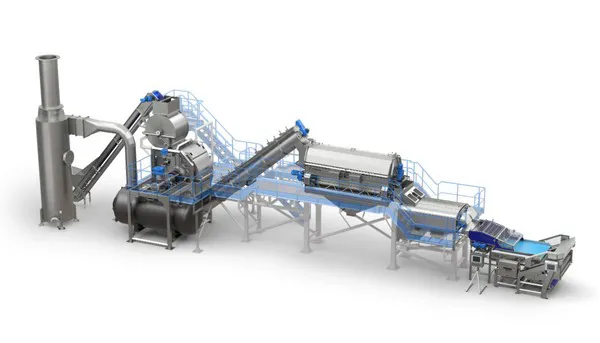Food waste is financial waste, yet when processing lines peel vegetables, they often let huge amounts of raw material get thrown away. Food losses can be as high as 30% during mechanical peeling and 20% with low-tech steam peelers – and much of this lost revenue is preventable.
Rather than accepting this, vegetable processors can do something about it. Instead of sticking with outdated peeling machines or buying low-cost peelers with low efficiency, processors can reduce waste significantly by investing in more effective technologies. There are four compelling reasons to do this.
One reason is that many vegetable processing lines around the world are now 20 to 30 years old. They need modernizing, and this is the perfect opportunity to install machinery that's more reliable and more efficient, including the best modern steam peelers.

Another reason is that vegetable processing has changed over the years. More big businesses are now participating in the industry, and more are responding to the growing demand for peeled vegetables as an ingredient for prepared meals. This has led to lines increasing both the volume and the variety of the vegetables they handle. Whereas low-volume processing lines might operate only for a few months each year during the harvesting season of one type of vegetable, medium- and large-volume lines handle different kinds of vegetables with harvesting seasons at different times of the year. Waste that’s tolerated for a few months, annually is intolerable when seen every day of the year.
The third reason is that huge advances have been made in peeling technologies. It remains true that mechanical peelers are wasteful and lower-tech steam peelers are also inefficient – but the more sophisticated steam peelers are something else. Technical innovations have greatly improved operating speed, peeling efficiency, controllability, energy use, and safety. Peeling quality is higher, uniformity greater, food waste usually lower than 10% and sometimes as low as 6.5%. On some lines this prevents the loss of an estimated 1,000 kg of vegetable material every hour. That’s an estimated saving of €200,000 per year.
And the fourth reason? Taking action to reduce food waste demonstrates a commitment to sustainability. This matters both for economic and environmental reasons. Because the global population is growing so fast, food production will need to increase by 70% by 2050, according to the United Nations’ Food and Agriculture Organization (FAO). Yet the food sector already accounts for about 30% of the world’s total energy consumption and 22% of greenhouse gas emissions. To make matters worse, some 14% of food produced is lost between harvest and retail. And it’s not only the UN that cares about these things: food buyers do, too. Consumers increasingly expect food businesses to adopt sustainable practices, and food retailers expect the same from their suppliers.
Peeler versatility is a big advantage
The standard-setter in designing and manufacturing steam peeling machines is Tomra Food, bestknown for its world-leading optical sorting and grading technologies. The unmatched effectiveness of Tomra’s solutions results from the company’s significant ongoing investment in research and development, a deep-rooted culture of innovation, and decades of experience working closely with processors to truly understand their operational challenges.
More than 500 Tomra steam peelers are currently in operation around the world. Approximately two-thirds of these process potatoes and one-third process other vegetables – mostly carrots, but also beetroot, butternut squash, kohlrabi, parsnip, pumpkin, and root celery. Some processors peel all of these products in the same factory, sometimes on the same line. This is made possible by the versatility of TOMRA’s sorters and steam-peelers; by these machines being designed to be easy to clean, which helps prevent cross-contamination; and by the machine controls having menus which allow operators to switch easily from one type or size of vegetable to another.
For more information:
Marijke Bellemans
Tomra
Tel: +32 (0)476 74 19 18
Email: marijke.bellemans@tomra.com
www.tomra.com/food
